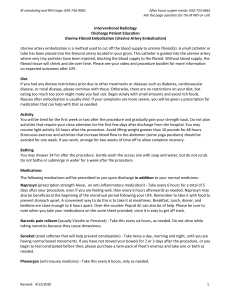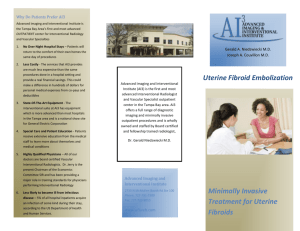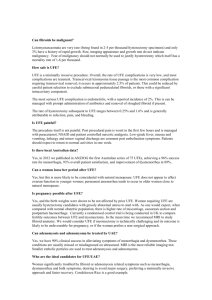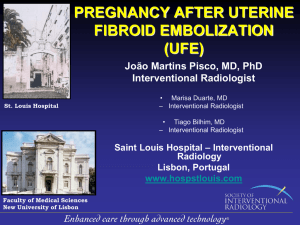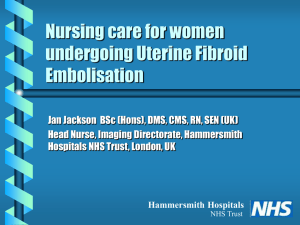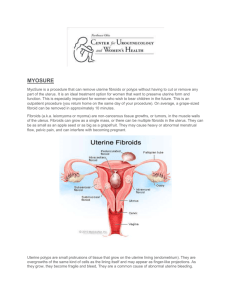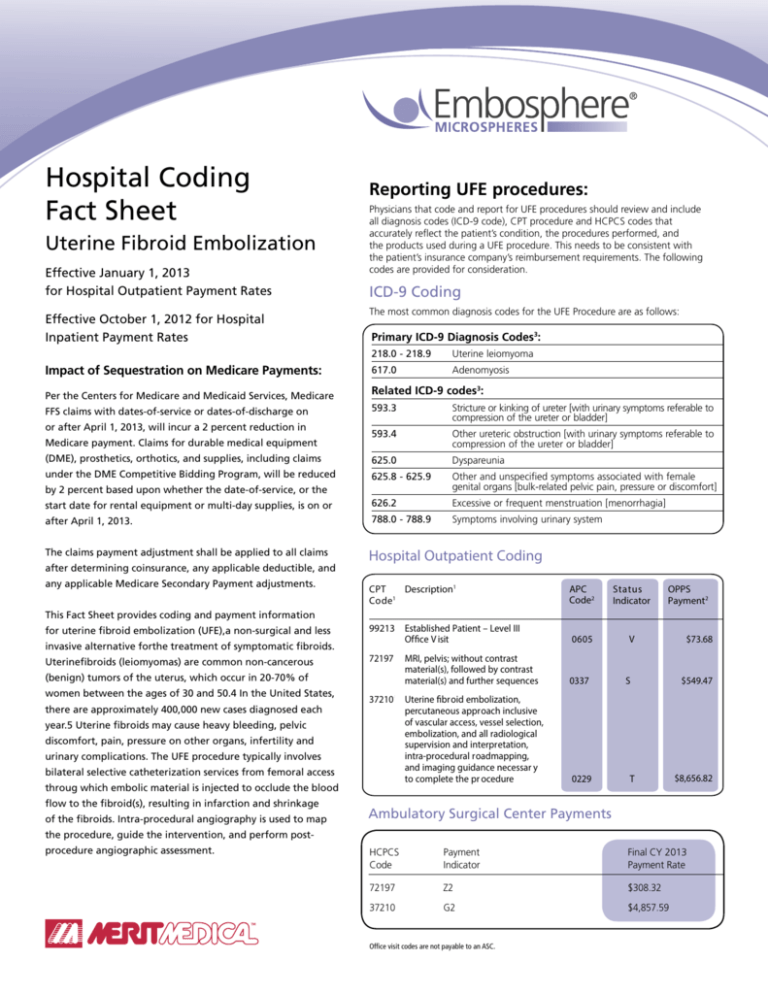
Hospital Coding
Hospital Coding
Fact
Fact Sheet
Sheet
Uterine Fibroid Embolization
Uterine Fibroid Embolization
Effective
1, 2013
EffectiveJanuary
January
1, 2010 for Hospital
for
Hospital
Outpatient
Outpatient Payment Payment
Rates Rates
Reporting UFE procedures:
Physicians that code and report for UFE procedures should
Physicians
should review
review and
and include
include
all diagnosis codes
all
codes (ICD-9
(ICD-9 code),
code),CPT
CPTprocedure
procedureand
andHCPCS
HCPCScodes
codesthat
that
accurately reflect the
and
accurately
the patient’s
patient’scondition,
condition,the
theprocedures
proceduresperformed,
performed,
and
the products used
needs
to to
bebe
consistent
with
the
used during
duringaaUFE
UFEprocedure.
procedure.This
This
needs
consistent
with
the patient’s
patient’s insurance
The
following
the
insurancecompany’s
company’sreimbursement
reimbursementrequirements.
requirements.
The
following
codes are provided
codes
provided for
forconsideration.
consideration.
ICD-9 Coding
Effective
October 1, 2009 for Hospital
Effective October 1, 2012 for Hospital
Inpatient Payment Rates
The most common diagnosis codes for
for the
the UFE
UFE Procedure
Procedure are
are as
asfollows:
follows:
Inpatient Payment Rates
Primary ICD-9 Diagnosis Codes3:
This Fact Sheet provides coding and payment
Impact of Sequestration on Medicare Payments:
information for uterine fibroid embolization (UFE),
a non-surgical
and
less invasive
alternative
Per
the Centers for
Medicare
and Medicaid
Services,for
Medicare
FFS
claims
with
dates-of-service
or
dates-of-discharge
on
the treatment of symptomatic fibroids. Uterine
or
after
April
1,
2013,
will
incur
a
2
percent
reduction
in
fibroids (leiomyomas) are common non-cancerous
Medicare payment. Claims for durable medical equipment
(benign) tumors of the uterus, which occur
(DME), prosthetics, orthotics, and supplies, including claims
in 20-70% of women between the ages of
under the DME
Competitive Bidding Program, will be reduced
30 and 50.1 In the United States, there are
by 2 percent based upon whether the date-of-service, or the
approximately
400,000
neworcases
diagnosed
start date for rental
equipment
multi-day
supplies, is on or
2
each
year.1, Uterine
fibroids may cause heavy
after April
2013.
bleeding, pelvic discomfort, pain, pressure on
The
claims
payment
adjustment
be applied
to all claims
other
organs,
infertility
andshall
urinary
complications.
218.0 - 218.9
Uterine leiomyoma
617.0
Adenomyosis
after determining coinsurance, any applicable deductible, and
The UFE procedure typically involves bilateral
selective catheterization services from femoral
access
whichcoding
embolic
injected
This
Factthrough
Sheet provides
andmaterial
payment is
information
to occlude
the blood
flow to
the fibroid(s),
for
uterine fibroid
embolization
(UFE),a
non-surgical and less
resultingalternative
in infarction
and
shrinkage
of the fibroids.
invasive
forthe
treatment
of symptomatic
fibroids.
Uterinefibroids
(leiomyomas)
are
common
non-cancerous
Intra-procedural angiography is used to map the
(benign)
tumors
of the
which occur
20-70% of
procedure,
guide
theuterus,
intervention,
andinperform
women between the ages of 30 and 50.4 In the United States,
post-procedure angiographic assessment.
any applicable Medicare Secondary Payment adjustments.
there are approximately 400,000 new cases diagnosed each
year.5 Uterine fibroids may cause heavy bleeding, pelvic
discomfort, pain, pressure on other organs, infertility and
urinary complications. The UFE procedure typically involves
bilateral selective catheterization services from femoral access
throug which embolic material is injected to occlude the blood
flow to the fibroid(s), resulting in infarction and shrinkage
of the fibroids. Intra-procedural angiography is used to map
the procedure, guide the intervention, and perform postprocedure angiographic assessment.
Related ICD-9 codes3:
593.3
Stricture or kinking of ureter [with urinary symptoms referable to
compression of the ureter or bladder]
593.4
Other ureteric obstruction [with urinary symptoms referable to
compression of the ureter or bladder]
625.0
Dyspareunia
625.8 - 625.9
Other and unspecified symptoms associated with female
genital organs [bulk-related pelvic pain, pressure or discomfort]
626.2
Excessive or frequent menstruation [menorrhagia]
788.0 - 788.9
Symptoms involving urinary system
Hospital
Outpatient
Coding
Hospital Outpatient
Coding
CPT Code1 Description1
CPT
Description1
C o d e1
APC CMS 2010 CMS 2009 Increase
APC
S t a tFee
us
OPPS
Code2
Fee
2
Code2
Indicator
Schedule
Schedule Payment
99213
37210 Established
Uterine Patient
fibroid – Level III 229
$6,558
$6,094
7.08%
$73.68
Office
V isit
0605
V
embolization
(UFE,
embolization of the
72197 MRI, pelvis; without contrast
uterine followed
arteries to
material(s),
bytreat
contrast
uterineand
fibroids,
$549.47
material(s)
further sequences
0337
S
leiomyomata),
37210* Uterine
fibroid embolization,
percutaneous
approach
percutaneous
approach
inclusive of
vascularinclusive
of vascular
vessel selection,
access, access,
vessel selection,
embolization,
and all
radiological
embolization,
and
all
supervision
and interpretation,
radiological
supervision
intra-procedural
roadmapping,
and interpretation,
intra
and imaging guidance necessar y
$8,656.82
to complete the pr ocedure
0229
T
*CPT Code 37210 has not been approved for performance in the
Ambulatory Surgical Center Setting.
*Ambulatory
CPT Code 37210 has
not been approved
performance in the
Surgical
CenterforPayments
Ambulatory Surgical Center Setting.
ICD-9 Proc Description
DRG CMS 2010 CMS 2009 Increase
Fee
Fee
HCPCS
Payment
Final CY 2013
Schedule Schedule
Code
Indicator
Payment Rate
99.29
Injection or infusion of
760
$4,518.15 $4,174.33
7.61%
72197Z2
$308.32
other therapeutic or
prophyiactic substance
761
$2,799.53 $2,586.50
7.61%
37210G2
$4,857.59
The information contained in this Fact Sheet is provided for informational purposes
only
and
no statement,
promise, or guarantee by Biosphere Medical
Office
visit represents
codes are not payable
to an ASC.
concerning levels of payment, reimbursement, or charges. Similarly, all CPT, HCPCS,
and other.
Medicare HCPCS Codes for
Hospital Outpatient Claims
The C Series of HCPCS codes may include device
categories that do not have other HCPCS codes
assigned. Hospitals are encouraged to report all
appropriate C codes regardless of payment status.
• C1887 - Catheter, guiding
(may include infusion/perfusion capability)
• C1769 - Guidewire
Medicare Hospital
Inpatient Coding
Effective October 1, 2007, the Medicare
Severity (MS) DRG system replaced the
previous CMS-DRG system. The MS-DRG
system divides some DRGs into levels based
on patient severity of illness: 1) those with
a Major Complication or Comorbidity (w/MCC),
2) those with a Complication or Comorbidity
that is not considered to be major (w/CC),
and 3) those without a Complication or
Comorbidity of either type (w/o CC/MCC).
Thorough physician dictation and medical
record documentation (including any
secondary diagnoses) are essential to
describing a complete patient profile for
appropriate coding and DRG assignment.
Download the complete, final rule at:
http://www.cms.hhs.gov/AcuteInpatientPPS/
A complete, updated CC and MCC list is
posted on the CMS Web site at:
http://www.cms.hhs.gov/AcuteInpatientPPS/
under downloads.
Hospitals submit inpatient claims to Medicare,
Medicaid, and private insurers on the UB-04
billing form (also called the CMS-1450). The
UB-04 displays ICD-9-CM diagnosis codes,
(principal diagnosis and up to eight additional
diagnoses), and ICD-9-CM procedure codes
(principal procedure and up to five additional
procedure codes) as well as other patient and
billing information to describe the patient’s
stay and use of resources.
Each inpatient stay is assigned to one MS-DRG.
Each MS-DRG is assigned a payment rate, and
is adjusted according to the individual hospital’s
teaching status, disproportionate share services
for treating low-income patients, and location in
urban versus rural regions. Note that DRGs do
not include payment for physician services,
which are reported and reimbursed separately.
Other health insurers may reimburse hospitals for
inpatient care using per diem rates, DRGs, case
rates, or a percentage of charges. Your hospital’s
contracting department should know how your
hospital’s private insurance contracts are set up.
Coverage Update
Medicare:
The typical UFE patient is a premenopausal woman between
25 and 50 years of age. UFE is rarely performed on the
Medicare (> age 65) population, therefore there is not a
national or local coverage determination for UFE. Local
Medicare carriers may cover on a case-by-case
basis and it is suggested that you contact your
local carrier prior for determination criteria.
Non-Medicare:
Most Non-Medicare insurance plans now provide at least
conditional coverage for Uterine Fibroid Embolization.
Private payers typically determine coverage for procedures
based on prior authorization. With UFE patients, unless
you are aware of the payer’s coverage policy for a specific
patient population, we recommend that you contact the
payer to seek prior authorization. If you ask about coverage
after procedure, it may result in unpaid claims, leaving
both the hospital and the physician without compensation.
Be sure to allow sufficient time to obtain prior authorization.
Important - Please Note: Merit Medical Systems,
Inc. gathers reimbursement information from third-party
sources and presents this information for illustrative purposes
only. This information does not constitute reimbursement or
legal advice and does not guarantee that this information
is accurate, complete, without errors, or that use of any of
the codes provided will ensure coverage or payment at any
particular level. Medicare may implement policies differently in
various parts of the country. Physicians and hospitals should
confirm with a particular payor or coding authority, such
as the American Medical Association or medical specialty
society, which codes or combinations of codes are appropriate
for a particular procedure or combination of procedures.
Reimbursement for a product or procedure can be different
depending upon the setting in which the product is used.
Coverage and payment policies also change over time and
Merit Medical Systems, Inc. assumes no obligation to update
the information provided herein.
1
CPT Copyright 2011 American Medical Association. All rights
reserved. CPT is a registered trademark of the American Medical
Association. Applicable FARS/DFARS Restrictions Apply to
Government Use. Fee schedules, relative value units, conversion
factors and/or related components are not assigned by the AMA,
are not part of CPT, and the AMA is not recommending their
use. The AMA does not directly or indirectly practice medicine or
dispense medical services. The AMA assumes no liability for data
contained or not contained herein.
2
Source: November 15, 2012 Federal Register. http://www.
cms.gov/Medicare/Medicare-Fee-for-Service-Payment/
HospitalOutpatientPPS/Hospital-Outpatient-Regulations-andNotices-Items/CMS-1589-FC.html
3
Source: The Educational Annotation of ICD-9-CM, Reno, NV;
Channel Publishing Ltd. Copyright 2011 Craig D. Puckett, Fifth
Edition
Mude-Nochumson H, Goldberg J. Fertility-sparing
treatment options for women with symptomatic
fibroids. The Female Patient. 2003; 28(11):21-26.
4
Hartmann KE, Birnbaun H, Ben-Hamadi R, et al. Annual
Costs Associated with Diagnosis of Uterine
Leiomyomata. Obstetrics and Gynecology, Vol. 108,
No. 4, October 2006.
5
Most insurance plans now provide at
least conditional coverage for Uterine
Fibroid Embolization. Below is a listing
of insurance companies reportedly
covering UFE.
• AETNA U.S. HealthCare
• Aetna Medicare/Medicaid - NY
• Alliance Mega Life & Health (CT)
• AmeriHealth
• Anthem BCBS Ohio
• Kaiser Permanente
• Personal Choice - PA
• Personal Choice - NJ
• BCBS CA Managed Care
• BCBS Michigan
• BCBS Central NY
• BCBS Tennessee
• BCBS Texas
• BCBS Western
• Blue Cross - CA
• BCBS - DE
• BCBS - Federal
• BCBS - IL
• BCBS - MI
• BCBS - NJ
• BCBS - NY
• BCBS - OR
• BCBS - PA
• Blue Shield - California
• BCBS - PA
• ChampVA - Virginia
• CIGNA (plan dependent)
• Conrail Metro Health
• Corporate Health Administrators (ND)
• Empire BC/BCBS New York
• Empire Metro Life & Health (NY)
• Golden Rule (IL)
• Great West Care (NJ)
• Greater Atlantic/Qual-Med (will approve on
case-by-case basis if patient is enrolled in a study)
• Guardian PHCS - PPO
• GW Health Plan [Virginia, Maryland,
Washington, DC]
• Kaiser Permanente (OR)
• Keystone Health Plan East (PA)
• Keystone Mercy Health Plan
• LabCore Benefits (CA)
• Medical Service Bureau (Blue Shield) Washington
• MAMSI (MDIPA; Optimum Choice;
MAMSI; Alliance PPO)
• National Assoc. of Letter Carriers
• New York Now Care
• Oaktree
• Oxford Health Plans CT, NY, NJ
• Postmasters Benefit Plans
• Prudential (plan dependent)
• Screen Actors’ Guild
• Travelers Oxford Liberty
• Vytra
• United Healthcare
• United Health Care Administrators (FL)
• US HealthCare
• US HealthCare HMO PA/NJ
Additional information regarding appropriate E/M coding
guidelines may be found in the 1997 Documentation Guidelines
for Evaluation and Management Services as published in partnership
with CMS and the American Medical Association.
www.merit.com
Merit Medical Systems, Inc. • 1600 West Merit Parkway • South Jordan, Utah 84095 • 1-801-253-1600 • 1-800-35-MERIT
Merit Medical EUROPE, MIDDLE EAST AND AFRICA (EMEA) • Amerikalaan 42, 6199 AE Maastricht-Airport • The Netherlands • Tel: +31 43 358 82 22
BioSphere Medical, S.A. • Parc des Nations - Paris Nord 2 • 383 Rue de la Belle Etoile • 95700 Roissy en France • France
Free phone for specific country: Austria 0800 295 374 • Belgium 0800 72 906 (Dutch) 0800 73 172 (French) • Denmark 80 88 00 24
France 0800 91 60 30 • Finland 0800 770 586 • Germany 0800 182 0871 • Ireland (Republic) 1800 553 163 • Italy 800 897 005
Luxembourg 8002 25 22 • Netherlands 0800 022 81 84 • Norway 800 11629 • Sweden 020 792 445 • UK 0800 973 115
©2013 Merit Medical Systems, Inc. All rights reserved.
MR07-062 Rev.G 03/13
402342001/B
ID 032613

